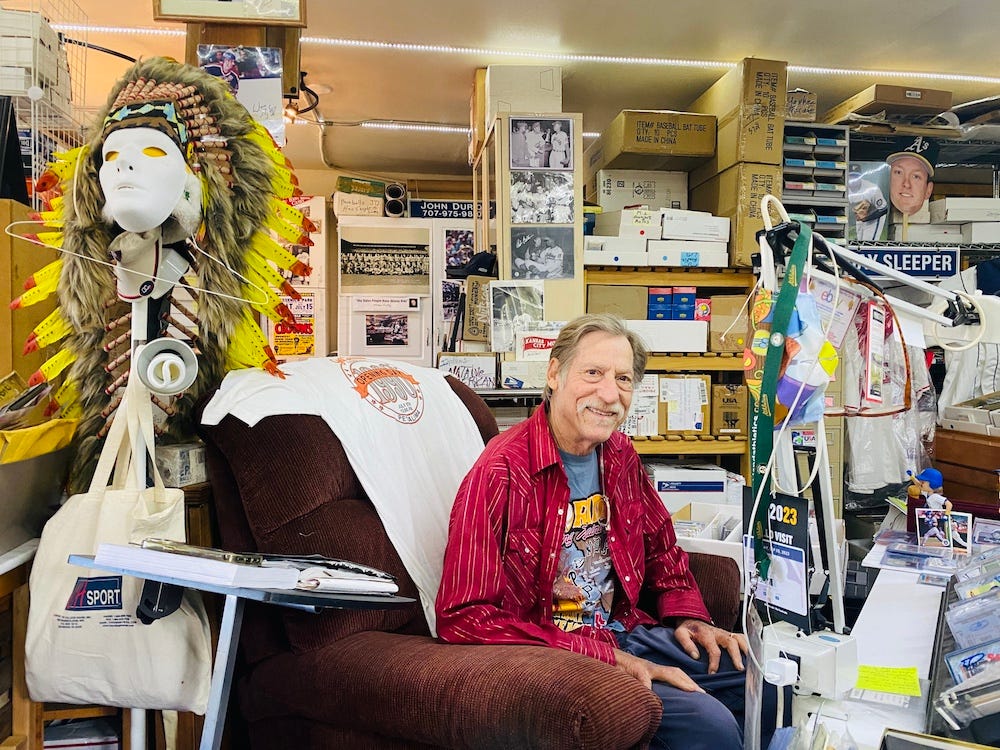It’s All In the Cards
John Duran is no rookie when it comes to baseball

Sebastopudlian John Duran has worn numerous hats in his time—as a Navy reservist, a business and restaurant entrepreneur, and a longtime local real estate broker, to name a few—but his true passion has always been collecting (and now selling) baseball cards. His hobby began when he was a child living in Los Angeles in the 1950s.
“I always was interested in baseball,” John said. “From the time I was as young as I could ever remember, I wanted to be Mickey Mantle and play center field for the Yankees. I grew up during the Golden Age of collecting.”
When he later joined the Navy Reserves, he left his beloved baseball card collection in the care of a good friend, who in turn gave it away. John never got it back, and his childhood passion lay dormant until the 1980s, by which time he’d established himself in Santa Rosa.
In the decades since, he’s accumulated another collection, which now consists of numerous pieces of memorabilia in addition to hundreds of thousands of baseball cards. But John is quick to explain that it’s a misunderstanding to count baseball cards in that way. Only some of the cards are valuable. Very few, in fact.
He notes that a 700-card collection might typically have only a few valuable cards in it, perhaps four, tops. These days, during his ongoing inventorying and sorting process, he donates large numbers of “low/no-value” cards to local charities and nonprofits.
What makes a card valuable? Its vintage, its condition, whether or not it’s in an opened or unopened package, whether or not it’s autographed, the popularity of the player and the scarcity of the card all play a part in determining each card’s value. And, pricing fluctuates with the times. Certain players are popular and certain ones aren’t. Others lose or gain favor over time.
John’s collection focuses mostly on past, present and future rookie players. He chose this niche market because of his interest in prospects — that is, in researching the young players who might become successful in their later years — and collecting their early cards before they become famous. Those cards tend to have extra value in the industry, because of their scarcity and early vintage.
“Baseball America is the bible of baseball; they publish magazines every month on baseball,” John says. “And they do a prospect report in the handbook. That’s done every year, and there’s 30 teams. They pick their 30 top players.”
John began selling his cards and memorabilia during the COVID-19 shutdown, on an experimental basis, via online auctions.
“The hobby’s never been as big as it is now,” he says. “It exploded because of the pandemic.”
Stuck inside with nothing to do for two years, people began revisiting their old collections, and their passion for memorabilia of all kinds was reignited.
At the time he began selling cards, John’s 30 years of cards and collectibles were stored, unsorted, in various locations. The inventorying and sorting process he’s embarked upon since is time-consuming, but yields treasures.
He has an extensive inventory of one-of-a-kind autographed baseball memorabilia, rare hard-to-find wax packs and boxes of premium baseball cards. He specializes in Minor League team sets and singles, and Major League Rookie cards from 1976 forward.
Nowadays, his entire collection resides in the “dugout,” an outbuilding in his backyard. Besides racks filled with boxes of inventoried and un-inventoried cards, there is a computer station, sorting racks and tables, shelves of collectibles, a shipping station, inventory binders; even a Mickey Mantle corner. It’s a scene of very well-organized chaos, a warehouse-in-miniature.
John receives orders from all over the world. Business is good, but he’s approaching the process slowly, not wanting demand to outstrip his ability to fulfill orders. Meanwhile, he spends his days surrounded by a museum-worthy archive of baseball memorabilia of all types, in his very own backyard.
“Part of what makes collecting baseball cards so much fun is that it connects us with our childhood in a visceral, nostalgic way,” he says. “Opening a sealed pack of baseball cards is still fun; there’s the excitement of trying to pull your favorite player, and it reminds me of when I was a kid and you could smell the bubblegum in a wax pack of cards. Even now, as adults, it takes us back to being a child again and all those memories, no matter what our age.”
Contact John Duran at RookieKards@sbcglobal.net to find out more about his collection.



